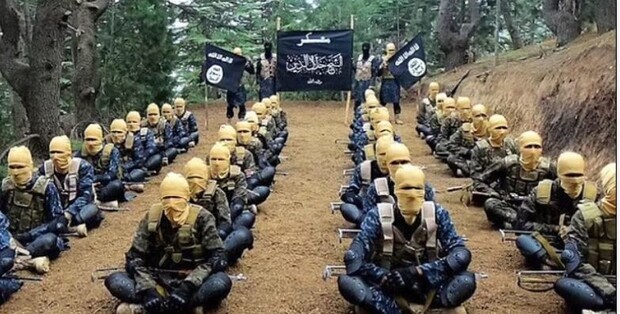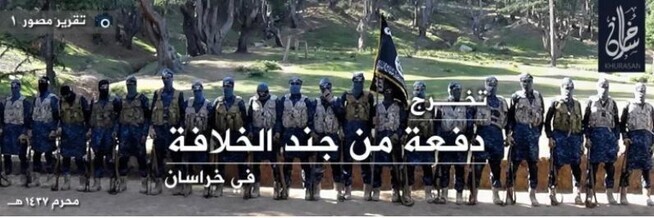hankyoreh
Links to other country sites 다른 나라 사이트 링크
Kabul airport attack puts Taliban’s ability to govern on trial

The first challenge to the Taliban’s rule after they returned to power in Afghanistan came not from the West or other outside forces, but from within, with the Islamist forces that they emerged out of.
Islamic State Khorasan (IS-K), the Afghan branch of the Islamic State, dealt a blow to the Taliban’s attempts to stabilize the situation when they carried out two suicide bombing attacks Thursday near Hamid Karzai International Airport in Kabul, a chaotic setting that was a major focus of global attention at the time.
With US President Joe Biden immediately vowing to carry out retaliatory strikes, some complex and delicate conflicts and dynamics appear poised to emerge between the US and other Western powers on one side, and the Taliban and Islamist armed groups on the other.
Extremists previously affiliated with the TalibanAmong Islamist forces, IS-K is the Taliban’s biggest rival and antagonist. It formed in 2015 as an Afghan branch of IS at a time when that organization was at its height as the biggest Islamist militant group, declaring itself a caliphate with authority in Iraq and Syria.
Consisting chiefly of extremists previously affiliated with the Taliban, IS-K is viewed even in Afghanistan as the most extreme and violent of terrorist organizations. It is also referred to as “ISIS-K” in the West, where officials still refer to IS by its previous acronym “ISIS,” which stands for “Islamic State in Iraq and Syria.”
Created from the outset as a rival force to the Taliban in Afghanistan, IS-K vehemently denounced the Taliban’s pursuit of peace negotiations with the US in Doha. In their view, the Taliban were forsaking the “jihad” by colluding with the enemy at a “luxury hotel.”
Over the past few years, IS-K has attacked girls’ schools and hospitals. It has even launched attacks against OB/GYN wards, killing pregnant people and nurses.
In August 2019, 63 people were killed in an IS-K suicide bombing at a wedding in Kabul. Over two dozen others were killed in an attack by gunmen at Kabul University in November 2020.

IS-K is based in Nangarhar, a province in eastern Afghanistan on the border with Pakistan. It also has ties with drug trafficking in the region.
At its height in 2016, it boasted around 3,000 members in its forces. That number fell sharply in the wake of a sweep campaign by the US and Afghan government forces and clashes with the Taliban. Today, it is estimated at somewhere between 500 and 1,000.
But IS-K currently counts a large number of experienced former Taliban members among its ranks — and its goal is an uncompromising jihad.
According to a UN report, since Shahab al-Muhajir took over as the organization’s new leader in June 2020, it has been redoubling its efforts to poach Taliban members displeased with its turn toward a more moderate approach as it pursued peace talks with the US.
The Taliban and IS-K have clashed directly in eastern Afghanistan, but the links between the two organizations haven’t been completely severed. One known link is the Haqqani network, a faction within the Taliban.
The Haqqani network boasts a powerful international terrorist organization even within the Taliban, with close ties to al-Qaeda early on. The network is seen by analysts as a “gray area” between the Taliban and IS-K.
Sajjan Gohel, a terrorism analyst with the Asia Pacific Foundation, told the BBC that “several major attacks between 2019 and 2021 involved collaboration between IS-K, the Taliban's Haqqani network and other terror groups based in Pakistan.”
Security in Kabul is currently in the hands of Khalil Haqqani, leader of the Haqqani network. The US is hunting Haqqani as an international terrorist element, offering a US$5 million bounty for his capture.
Many prisoners were released from Pul-e-Charkhi prison in Kabul when the Taliban entered the capital. Among them were members of IS-K and al-Qaeda.
Taliban discord during IS-K sweepThe US had been warning for several days of possible terrorist attacks by IS-K. Not only had the Taliban been in conflict with the US and other Western powers over the evacuation of foreign nationals and Afghan cooperators, but the chaotic conditions around the airport in Kabul made it a prime target for a terrorist attack.
For the Taliban, getting the Islamist forces under control has emerged as a top priority in the wake of the attacks. In their peace agreement with the US in Doha, the Taliban said they would prevent the use of Afghanistan as a launch base for terrorist activities by al-Qaeda and other international terrorist organizations.
The issue was a key factor in the US decision to withdraw its troops, and it is also crucial in terms of the Taliban being recognized as a regime at the head of a “normal state” and drawing the international assistance that will be needed for postwar reconstruction.
But if the Taliban do proceed with an IS-K sweep, it will also have a definite impact on internal relations with the Haqqani network and al-Qaeda. That, in turn, may lead to major objections and conflict in and around the Taliban.

The Biden administration finds itself under siege at the moment amid condemnation at home and abroad for its “hasty” decision to pull its troops out, which critics say allowed the Taliban to quickly claim the capital.
Kevin McCarthy, the Republican minority leader in the US House of Representatives, has called for legislation delaying the withdrawal until all Americans have been removed from Afghanistan. Republican Senator Ben Sasse has said that the US military should expand its control beyond the area around the Kabul airport — or even restore its Bagram Air Base.
But White House press secretary Jen Psaki has asserted that the US plans to stick to its Tuesday deadline for withdrawing troops. Neither the US nor the Taliban are currently likely to accept an extension of the withdrawal timeline, which would only prolong the chaos in Kabul and contribute further to the potential for additional terrorist attacks.
The Biden administration now finds itself in the dilemma of having to retaliate against the terrorist attacks while also safely completing its evacuations by the deadline.
Some analysts have suggested that the situation could actually be an opportunity for establishing “common ground” between the US and Taliban.
According to this view, Biden cannot proceed with the retaliation he has pledged without Taliban cooperation, while the Taliban could use the opportunity to cut ties with al-Qaeda and others. It’s a somewhat optimistic view, which predicts that the situation could promote a more moderate shift in the Taliban leadership while laying the groundwork for cooperation with the West.
By Jung E-gil, senior staff writer
Please direct comments or questions to [english@hani.co.kr]

Editorial・opinion
![[Column] Welcome to the president’s pity party [Column] Welcome to the president’s pity party](https://flexible.img.hani.co.kr/flexible/normal/500/300/imgdb/original/2024/0515/3917157400447943.jpg) [Column] Welcome to the president’s pity party
[Column] Welcome to the president’s pity party![[Editorial] Korea must respond firmly to Japan’s attempt to usurp Line [Editorial] Korea must respond firmly to Japan’s attempt to usurp Line](https://flexible.img.hani.co.kr/flexible/normal/500/300/imgdb/original/2024/0514/2317156736305813.jpg) [Editorial] Korea must respond firmly to Japan’s attempt to usurp Line
[Editorial] Korea must respond firmly to Japan’s attempt to usurp Line- [Editorial] Transfers of prosecutors investigating Korea’s first lady send chilling message
- [Column] Will Seoul’s ties with Moscow really recover on their own?
- [Column] Samsung’s ‘lost decade’ and Lee Jae-yong’s mismatched chopsticks
- [Correspondent’s column] The real reason the US is worried about Chinese ‘overcapacity’
- [Editorial] Yoon’s gesture at communication only highlights his reluctance to change
- [Editorial] Perilous stakes of Trump’s rhetoric around US troop pullout from Korea
- [Guest essay] Preventing Korean Peninsula from becoming front line of new cold war
- [Column] The state is back — but is it in business?
Most viewed articles
- 1[Column] Welcome to the president’s pity party
- 2Could Korea’s Naver lose control of Line to Japan?
- 3[Editorial] Transfers of prosecutors investigating Korea’s first lady send chilling message
- 4US has always pulled troops from Korea unilaterally — is Yoon prepared for it to happen again?
- 5Korean opposition decries Line affair as price of Yoon’s ‘degrading’ diplomacy toward Japan
- 6Unexpected rate of AI development requires timely discussion of side effects
- 7[Correspondent’s column] The real reason the US is worried about Chinese ‘overcapacity’
- 8Major personnel shuffle reassigns prosecutors leading investigations into Korea’s first lady
- 9Second suspect nabbed for gruesome murder of Korean in Thailand, 1 remains at large
- 10Number of foreign residents in S. Korea triples over ten years